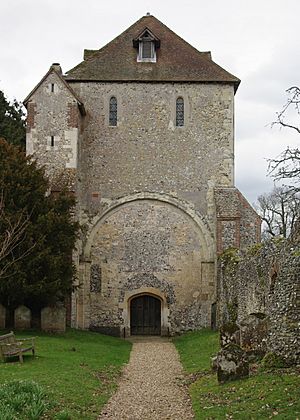Alien priory facts for kids
Alien priories were special religious places in England. These could be a monastery (for monks) or a convent (for nuns). What made them "alien" was that they were controlled by a main religious house outside England. Most of the time, this main house was in France.
Contents
History of Alien Priories
Alien priories were like small branches of foreign religious houses. They were mostly English properties owned by French monasteries.
Early Beginnings
This idea started a long time ago, even before the Norman conquest of England. For example, in 912, Ælfthryth, Countess of Flanders, who was the daughter of Alfred the Great, gave some land to a monastery in Ghent, France. Later, Edward the Confessor also gave land in Deerhurst to a monastery in France called St Denis.
After the Norman Conquest
The number of alien priories grew a lot after the Norman conquest of England in 1066. Many Norman lords had built monasteries in France. These French monasteries often sent monks to England to look after their new properties there.
For instance, William the Conqueror gave land in Dorset to the Abbey of Saint-Étienne, Caen in France. Later, during the time of King William II, a priory was founded in Abergavenny. It was controlled by a monastery in Le Mans, France.
The term "Alien Priory" didn't always mean there was a building with monks. It could just mean land owned by a French religious house.
How They Worked
Some of these priories had more freedom than others. In some, the leader (called a prior) was chosen by the main monastery in France. In others, the monks in England got to choose their own prior. If they chose their own prior, the land belonged to the English priory. It could not be sold by the French main house.
These English priories usually paid a fixed amount of money each year to their main house in France. This payment was called an apport.
Kings and Wars
Kings in England often took control of alien priories, especially during wars with France.
- King John (1199-1216) made them pay their apport directly to him instead of to France.
- During the reign of King Henry III (1216-1272), some alien priories were closed. Their money was taken by the king. However, the king often gave these properties to other English monasteries.
Seizures During Wars
In 1294, King Edward I was at war with France. He seized about a hundred alien priories. He used their money to help pay for the war. To stop foreign monks near the coast from helping invaders, he moved many of them inland.
King Edward II also took control of these priories. But he sometimes let the priors manage them if they paid him the apport.
When King Edward III became king, he first gave many priories back to their French owners. But when war with France started again, he seized them once more. They stayed in his hands for 23 years. After a peace treaty in 1361, most were returned. But when war restarted eight years later, they were seized again.
During the time of King Richard II, most alien priories remained under the control of the English Crown.
The End of Alien Priories
In 1378, all monks in alien priories were sent out of England. Most alien priories finally closed for good under King Henry V in 1414. Only a few, like Modbury Priory in Devon, managed to survive for a bit longer.


